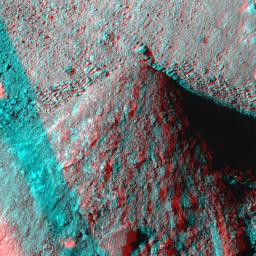
|
Picking up Clues from the Discard Pile (Stereo)
- Click the image above for a larger view
- Full-Res JPEG (512 x 512) (86.8 kB)
- Full-Res TIFF (512 x 512) (787.5 kB)
Caption:
As NASA's Phoenix Mars Lander excavates trenches, it also builds piles with most of the material scooped from the holes. The piles, like this one called "Caterpillar," provide researchers some information about the soil.
On Aug. 24, 2008, during the late afternoon of the 88th Martian day after landing, Phoenix's Surface Stereo Imager took separate exposures through its left eye and right eye that have been combined into this stereo view. The image appears three dimensional when seen through red-blue glasses.
This conical pile of soil is about 10 centimeters (4 inches) tall. The sources of material that the robotic arm has dropped onto the Caterpillar pile have included the "Dodo" and ""Upper Cupboard" trenches and, more recently, the deeper "Stone Soup" trench.
Observations of the pile provide information, such as the slope of the cone and the textures of the soil, that helps scientists understand properties of material excavated from the trenches.
For the Stone Soup trench in particular, which is about 18 centimeters (7 inches) deep, the bottom of the trench is in shadow and more difficult to observe than other trenches that Phoenix has dug. The Phoenix team obtained spectral clues about the composition of material from the bottom of Stone Soup by photographing Caterpillar through 15 different filters of the Surface Stereo Imager when the pile was covered in freshly excavated material from the trench.
The spectral observation did not produce any sign of water-ice, just typical soil for the site. However, the bigger clumps do show a platy texture that could be consistent with elevated concentration of salts in the soil from deep in Stone Soup. The team chose that location as the source for a soil sample to be analyzed in the lander's wet chemistry laboratory, which can identify soluble salts in the soil.
Background Info:
The Phoenix Mission is led by the University of Arizona, Tucson, on behalf of NASA. Project management of the mission is by NASA's Jet Propulsion Laboratory, Pasadena, Calif. Spacecraft development is by Lockheed Martin Space Systems, Denver.
Photojournal Note: As planned, the Phoenix lander, which landed May 25, 2008 23:53 UTC, ended communications in November 2008, about six months after landing, when its solar panels ceased operating in the dark Martian winter.
Cataloging Keywords:
| Name | Value | Additional Values |
|---|---|---|
| Target | Mars | |
| System | ||
| Target Type | Planet | |
| Mission | Phoenix | |
| Instrument Host | Phoenix Lander | |
| Host Type | Lander | |
| Instrument | Solid-State Imaging (SSI) | |
| Detector | ||
| Extra Keywords | Color, Shadow, Water | |
| Acquisition Date | ||
| Release Date | 2008-09-01 | |
| Date in Caption | 2008-08-24 | |
| Image Credit | NASA/JPL-Caltech/University of Arizona/Texas A&M University | |
| Source | photojournal.jpl.nasa.gov/catalog/PIA11057 | |
| Identifier | PIA11057 | |
